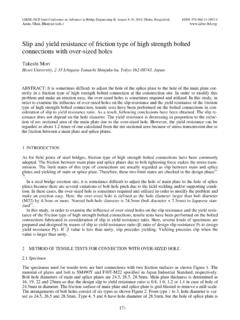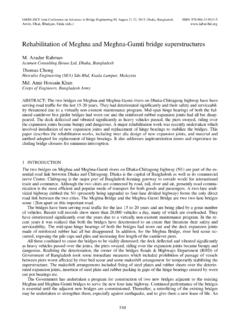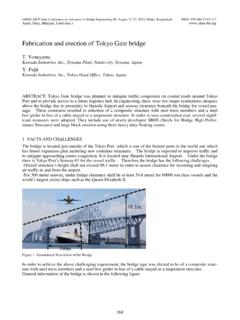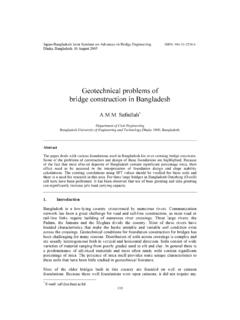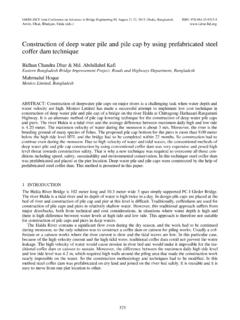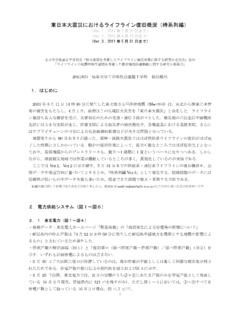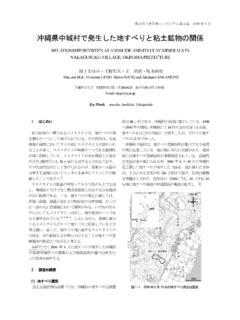Transcription of Recent trend on design and construction of steel …
1 121 INTRODUCTION Specifications for Highway Bridge and Standards Specifications for steel and steel -concrete Hybrid Railway Bridges are introduced. The former is based on the Allowable Stress design (hereinafter the ASD ) and the latter is based on the Limit State design (hereinafter the LSD ), and both are legal codes. Hence, in Japan, the design of almost all highway and railway steel and steel -concrete composite bridges has been carried out by employing them. Committee on steel Structures in Japan Society of Civil Engineers (hereinafter the jsce ) is now making Standard Specifications for steel and steel -concrete Composite Structures. It consists of 6 volumes and, among them, five volumes have been published. The above jsce code is based on performance-based design .
2 Since it is the first time design code in civil steel structural engineering in Japan, the detailed explanation is made in this paper. In Japan, due to lack of the financial budget for public work, technological ideas or proposition for attain-ing the cost cut and higher durability are being strongly requested at the stage of new bridge construction . In this situation, the competition between steel and concrete alternatives is now becoming severe. To cope with this subject, the development and proposition of long-life, steel -concrete composite bridges, which utilized each merit from steel and concrete, is active. Furthermore, it is emphasized, for the design of composite girder bridges, that the shift of design concept from ASD to LSD is important.
3 Because, utilizing inelastic strength of the composite girder contributes to enhance the competitiveness. From this viewpoint, the effort of LSD establishment for the design of composite bridges carried out by our research group is introduced. 2 design CODES FOR HIGHWAY AND RAILWAY BRIDGES Japan Road Association is in charge of issuing Specifications for Highway Bridges (Japan Road Association 2003). Photo 1 is the cover of it, which is 2003-version. The design of almost all highway bridges in Japan follows it. The first version was issued in 1939, and modern style or format of it was established in 1972-IABSE- jsce Joint Conference on Advances in Bridge Engineering-II, August 8-10, 2010, Dhaka, Bangladesh. ISBN: 978-984-33-1893-0 Amin, Okui, Bhuiyan (eds.)
4 Recent trend on design and construction of steel and composite bridges in Japan Nagaoka University of Technology, Nagaoka, Niigata, Japan E. Yamaguchi Kyushu Institute of Technology, Kitakyushu, Fukuoka, Japan T. Yoda Waseda University, Tokyo, Japan K. Nogami Tokyo Metropolitan University, Tokyo, Japan ABSTRACT: This paper first introduces design codes for steel and steel -concrete composite bridges in Japan. Almost all roadway and railway bridges in Japan have been designed according to Specifications for Highway Bridges and according to Standard Specifications for steel and steel -concrete Hybrid Railway Bridges, re-spectively. Standard Specifications for steel and composite structures issued from Japan Society of Civil En-gineers is introduced in detail, since it is the first time performance-based design in civil steel structural engi-neering field.
5 The latter part of this paper deals with current construction trend on steel and steel -concrete composite bridges in Japan. Evaluating formulae of ultimate flexure, shear and coupled strength of the com-posite and double-composite girders are proposed. It is for the establishment of the Limit State design of composite girder bridges. 13version. Since then, even though small revision was made, essential change has not been made. It is based on ASD and specification-based design , and it has been announced that LRFD format will be employed in the next version under revision. Railway bridges have been designed using Standard Specifications for steel and Hybrid Railway Bridges (Railway Technical Research Institute 2008).
6 Photo 2 is the cover of it. In 1992, the design concept was shifted from ASD to LSD. 3 jsce STANDARD SPECIFICATIONS FOR steel AND COMPOSITE STRUCTURE General Committee on steel Structures of jsce is making efforts for the advancement of technology in the field. The technical subcommittees are set up to solve specific problems, and design codes are complied and constantly updated based on the latest research outcomes. jsce design codes are not mandatory. They are rather model codes, but much more advanced than codes of practice which tend to be conservative. In 2000, Committee on steel Structures formed a special subcommittee on performance-based design to study this new design approach in the field of steel structures. In 2003, the subcommittee published a report entitled For construction of Performance-based design for steel Structures ( jsce 2003).
7 Following this achievement, Subcommittee on Standard Specifications for steel and Composite Structures was set up in 2004. The subcommittee consists of six task forces, each of which deals with a specific phase of construction . The standard specifications thus would be of six volumes: General Provisions, Structural Planning, design , Seismic design , construction and Maintenance. Three books have been already published from jsce : the first book combines three volumes of General Provisions, Structural Planning and design ( jsce 2007), while the second and third books are Volume of Seismic design ( jsce 2008) and Volume of construction ( jsce 2009). The last book on Maintenance is expected to come out in 2010. The covers of the report ( jsce 2003) and the books ( jsce 2007, 2008, 2009) above explained are shown in Photos 3 - 6.
8 The first book ( jsce 2007) is already available in English ( jsce 2010), and Photo 7 shows the cover. As technology advances continuously and new demands on structures come up constantly, the preparation for the revision of the published volumes is always underway. Outline of the first book of jsce Standard Specifications Volume of General Provisions gives the basis of the standard specifications for steel and composite struc-tures. It describes the design approach, the format for verification equations, terminology and so on, which all the volumes follow. Volume of Structural Planning shows the issues that must be clarified at the planning phase of design . Volume of design presents specific design requirements for the steel and composite structure.
9 This is the performance-based type of design code. Hence, the code does not have the specific design proce-dures/verification equations that designers must follow. All that code matters is that the structure will perform satisfactorily; the way to ensure the satisfactory performance of the structure in the design phase is no con-cern of the code. For the sake of design convenience, however, the code provides the verification equations as well that designers may use to verify the performance of the structure. These are often called deem-to-satisfy design equations. The performance requirements that Volume of design has recognized are safety, serviceability, restorabil-ity, durability, social and environmental compatibility and constructability.
10 In general, the satisfaction of the performance requirements is to be verified referring to the associated limit state. However, it is not possible to set up the limit state for all the performance requirements. Some performance items in the social and envi-ronmental compatibility, for example, need to be treated as an optimization problem instead. Style of jsce Standard Specifications Committee on steel Structures published design Code for steel Structures in 1997 ( jsce 1997). The cover is shown in Photo 8. The code is based on LSD. This is a conventional design code, and the verification equa-tions are specified. Volume of design ( jsce 2007) is actually the update of the above code ( jsce 1997). However, no equations are given, and the difference between two codes is obvious.
